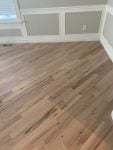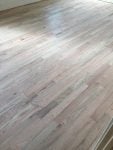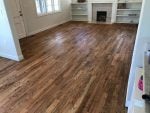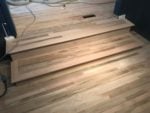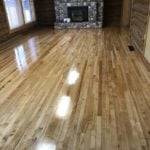Recently we’ve received many requests for installing new hardwood beside existing hardwood. The reasons vary from water damage repairs, removing a wall and weaving in hardwood to fill in the gap, to just adding hardwood in an additional room. Whatever the reason, there are some things to think about before you decide to jump in.
No matter the age of your existing hardwood floor, there will be a big chance we cannot get the exact same brand and type of grain as your original wood. Manufacturers go out of business, they change their widths available or types available, their trees grow differently, etc. We also won’t know the brand unless we remove a board and look at the bottom. In 99 percent of the cases we get, we do not guarantee the new hardwood will have the same ‘look’ as the original hardwood. We will get as close as we possibly can with the resources we have available to us. BTW, the hardest species to match is Maple.
Second, your floor has aged. Whether it is one year old or 20 years old, it has aged. And with aging comes change. The biggest change is in the color. Over time wood and the finish start to go yellow or orange. There is nothing you can do about it; it just happens. You can slow the aging process by keeping the sun off the floors, but this won’t stop it completely. This is the main reason why we will not install additional flooring without sanding and refinishing the existing floor at the same time. There is just no way to manipulate new flooring to mimic the aged look.
Third, if your existing floor is stained, there is no way to match it. We will need to sand the entire floor and restain. Stain fades over time, brands change, formulas change, etc. The new wood will absorb differently than the old wood did when it was new depending on how it was sanded as well as some other variables.
These reasons will play an impact once we install the new floor against the existing one. Even once we sand the entire floor, the color of the new wood against the existing wood may look different in grain color, overall pattern, and overall color. They will also accept the stain differently. The new wood may end up lighter or darker than the existing wood because of all the variables mentioned.
As mentioned before, we will try our hardest to make the new wood as close to the original wood as possible. In many cases, you will never be able to see the difference. In some cases, you will. This is why we don’t guarantee that we will match new wood with the existing.
If you have any questions about adding new wood to existing wood, let us know!





